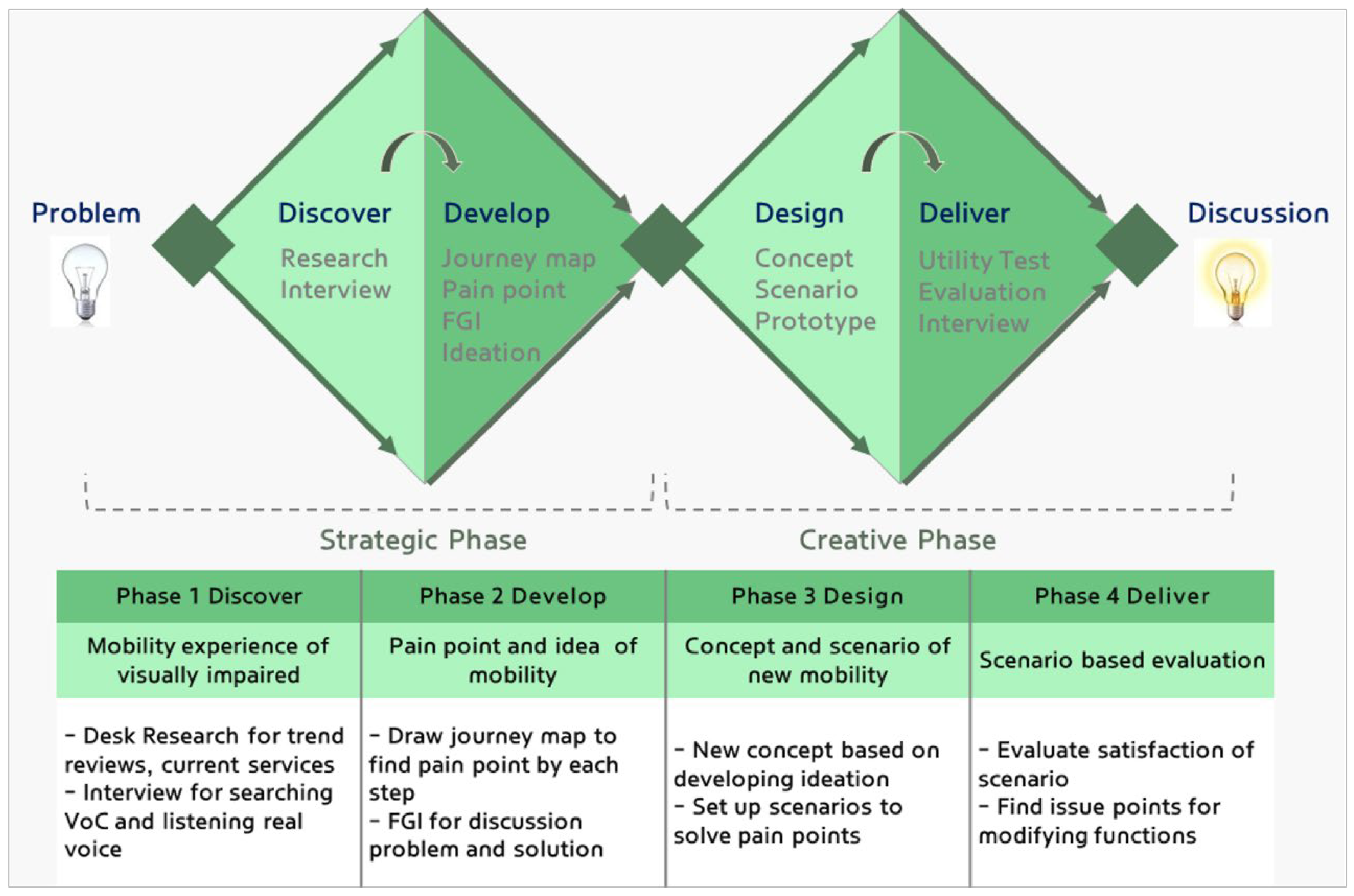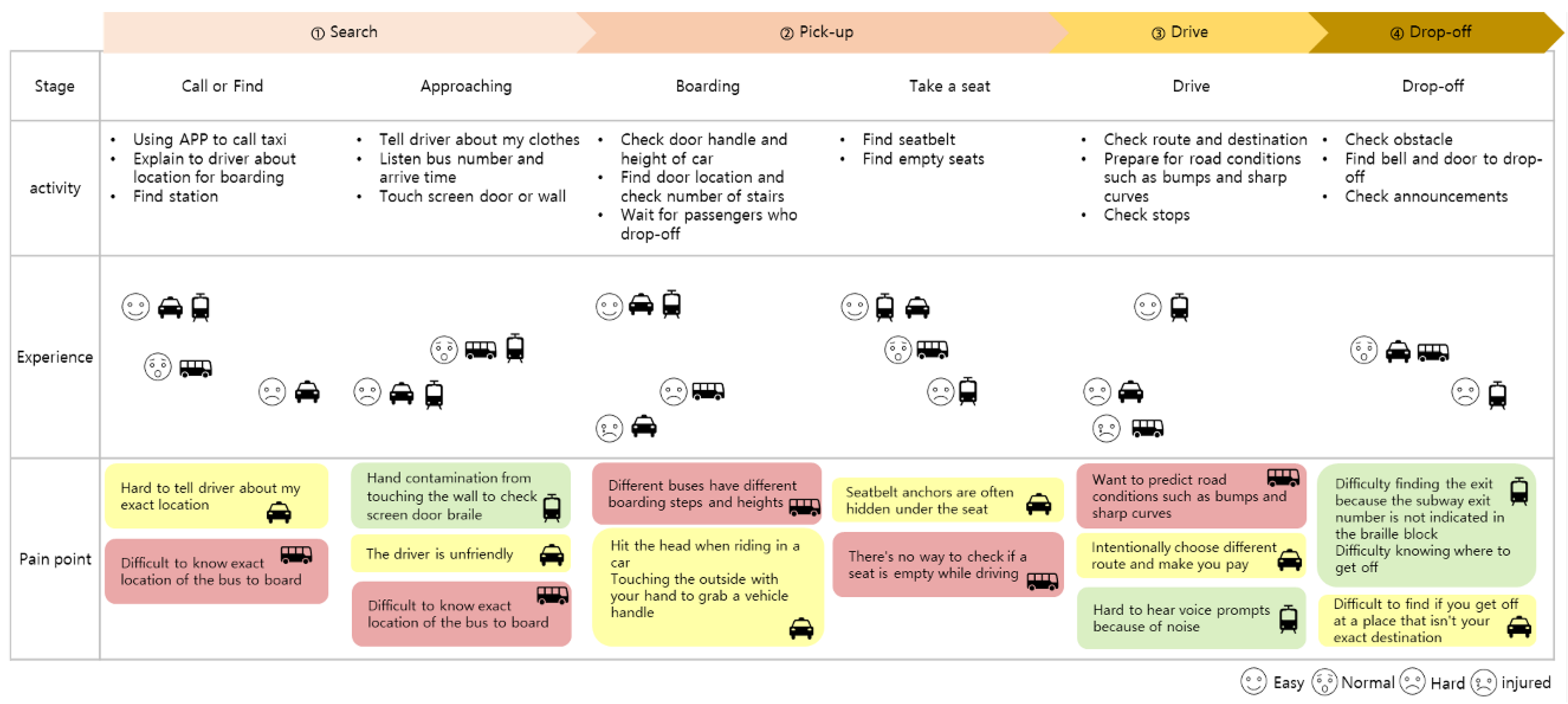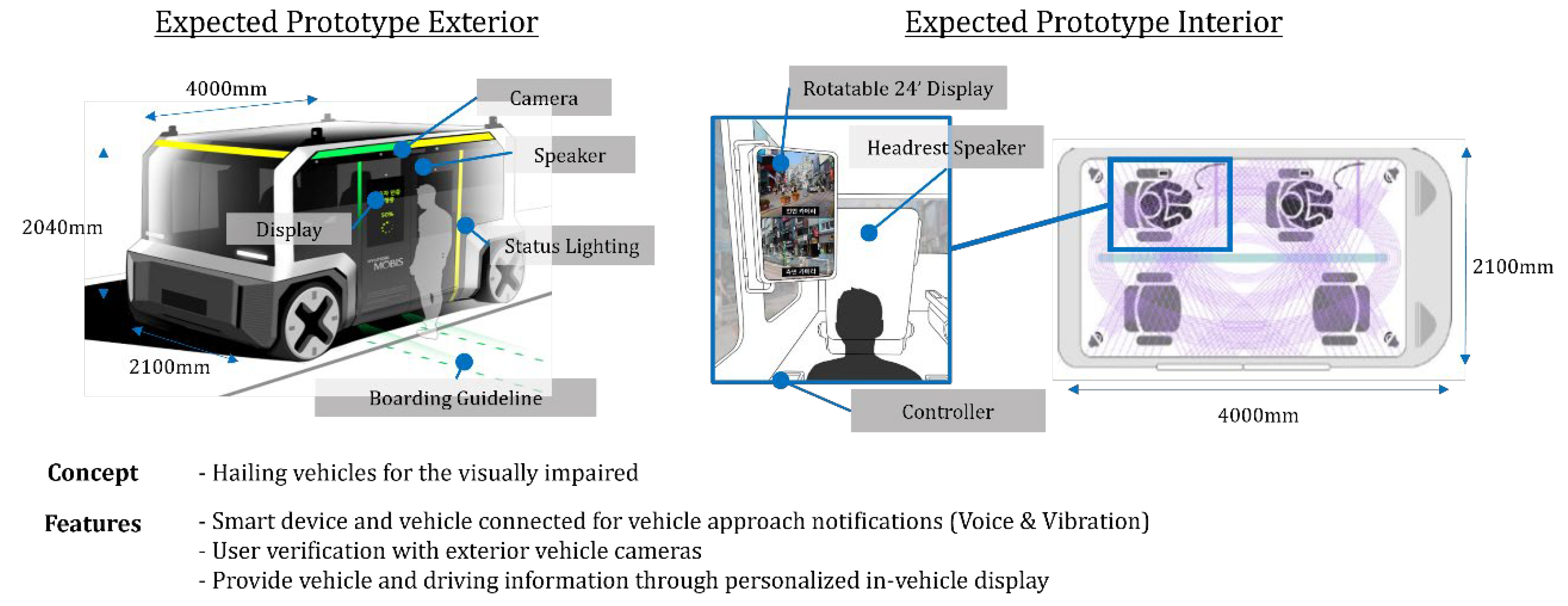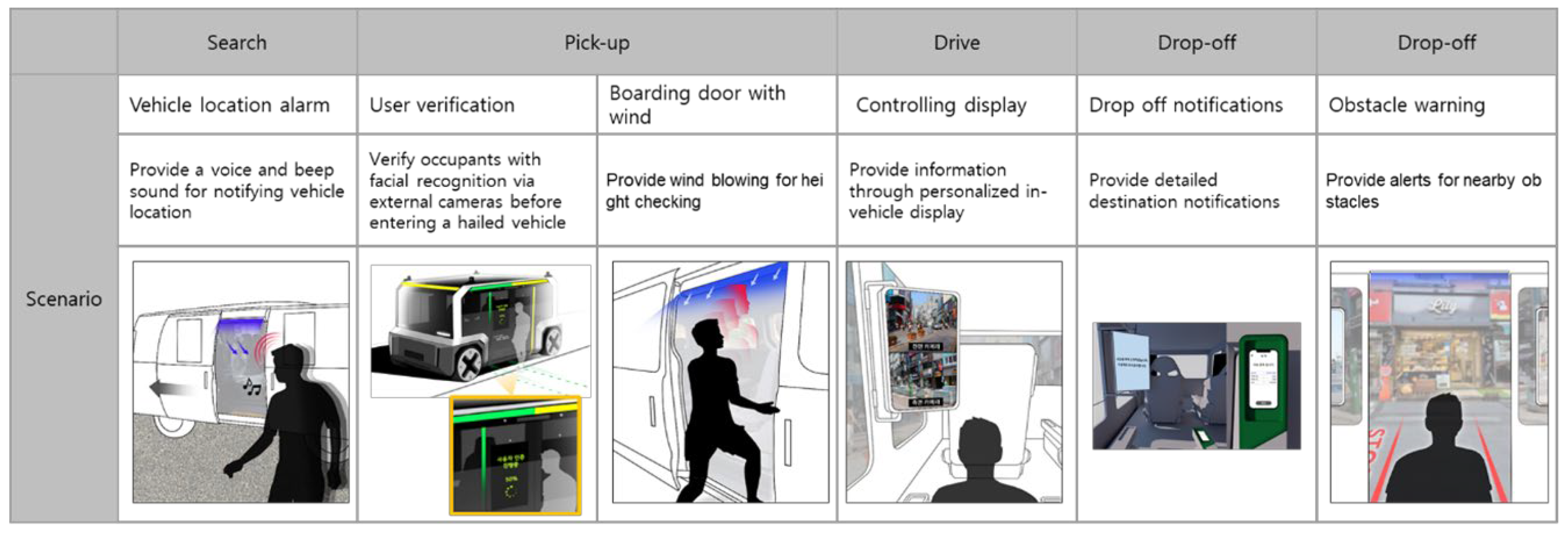1. Introduction
Worldwide, more than 285 million people experience visual impairment, including 39 million with total blindness [
1]. As populations age, this number is expected to increase. Visual impairment varies from total blindness to low vision and amblyopia, significantly restricting mobility and independence compared to non-disabled individuals [
2]. Visually impaired people often rely on canes, guide dogs, or human assistance for daily movement, particularly in public transportation where they face challenges such as identifying stops, accessing vehicles, and disembarking safely.
The emergence of ride-sharing services like Uber and Lyft has improved mobility by offering features such as vehicle location alerts, pre-trip planning, and real-time notifications, which reduce the need for physical assistance during transit [
3]. Advancements in autonomous vehicle (AV) technologies, particularly SAE Level 3 and above, present further opportunities to enhance independent mobility for visually impaired users by eliminating the need for a driver [
4]. However, despite these technological advances, most AV designs and shared mobility services remain tailored primarily for non-disabled users, limiting their inclusivity.
To make autonomous vehicles fully accessible, design strategies must directly address the unique needs of visually impaired individuals. Inclusive vehicle design can reduce mobility barriers, expand movement range, and foster greater social inclusion. However, the complexity of visually impaired users’ mobility challenges requires specialized design and evaluation methods. Existing UX frameworks often overlook the diverse sensory and interaction needs of this population, highlighting a need for more inclusive approaches [
5,
6,
7,
8].
This study proposes a future mobility concept tailored for visually impaired users by modifying the Double-Diamond design framework. The model was adapted to simultaneously address problem identification and solution development, ensuring both user needs and technical feasibility are considered throughout the process. Key pain points were identified through interviews and expert workshops, guiding the design of vehicle concepts with features such as multimodal feedback, voice navigation, and tactile guidance.
By focusing on the specific needs of visually impaired users, this research aims to advance the design of autonomous vehicles, ensuring accessibility and enhancing the mobility experience. The findings contribute to the ongoing development of inclusive transportation technologies, emphasizing the importance of user-centered design in the evolution of autonomous systems.
3. Method
3.1. Developing an Evaluation Method for Future Mobility Experience
Within this study, the proposition of a fitting UX evaluation methodology for enhancing the mobility experience of visually impaired individuals has been undertaken. The all-encompassing objective of the evaluation methodology is the discernment of barriers inherent within customary mobility engagements, coupled with the generation of innovative solutions aimed at the establishment of a travel environment that is both disability-centered and accommodating. To pursue this overarching objective, the Double-Diamond model UX evaluation framework devised by the Design Council (2004) was adopted and subsequently subjected to revision within the purview of this investigation. This adaptation engenders a transformation of the conventional four-stage paradigm of discovery, definition, development, and delivery inherent to the model into a sequential progression characterized by discovery, development, design, and delivery phases (See
Figure 1).
The fundamental rationale behind these modifications is the disparities observed between extant models and our distinctive approach. While the prevailing methodological construct bifurcates the phases of problem identification and solution ideation, our study embarked on a course of action to amalgamate these phases. This endeavor materialized through the user journey map and the Expert Group Idea Generation (EGID) process, thereby discerning pain points encountered by individuals with visual impairments and proffering and subsequently materializing solutions. For this purpose, the protocol for idea generation was harnessed in concert with the preexisting FGI method, summoning experts from pertinent domains to partake in a collective discourse, culminating in the conception of ideas and solutions as a collective attempt.
The Discover phase’s commencement marks our research flow’s inception, a foundational prelude vital for elucidating problems and attaining contextual comprehension. This phase encompasses the execution of in-depth interviews (IDIs) involving respondents afflicted with visual impairments, thus furnishing invaluable insights into their multifarious encounters across diverse transportation modalities. These insights, once acquired, are meticulously amalgamated into a holistic user journey map, meticulously underscoring salient pain points. In response to these necessities, a methodical iteration-driven approach to idea generation is employed, wherein the subsequent development phase assumes the responsibility for the proper visualization and precise refinement of these conceptual propositions.
Subsequently, within the ambit of the design stage, efforts were undertaken to embody future mobility based on the vehicle type concept following the ideas delineated in the antecedent stage. This phase is hallmarked by the metamorphosis of abstract notions into tangible, discernible propositions. Ultimately, the culminating phase pertains to the delivery stage, wherein the developed mobility concept is validated. Designed with precision to outfit the visual impairer’s unique requirements, the main object of this phase encompassed the exhaustive assessment of its usability and efficacy.
3.2. Research Procedure
This phase is characterized by transforming abstract concepts into tangible, observable propositions. Ultimately, the culminating step is validating the developed mobility concept in the delivery stage. The primary focus of this phase lies in the comprehensive assessment of usability and efficacy, meticulously tailored to meet the unique requirements of the visually impaired.
The Discover and Develop stage entail the exploration of issues and the derivation of pain points. In this study, the mobility experiences of the visually impaired were ascertained through desk research and in-depth interviews (IDIs), subsequently formulated into ideas via journey mapping and focus group interviews (FGIs).
IDIs involved six participants during the Discover stage, including individuals with visual impairments. Inconveniences and suggestions about the mobility experiences of the visually impaired were gathered. The participants encompassed experts in visually impaired mobility and individuals with disabilities. Participants 1 and 2, possessing independent mobility, are visually impaired. Participants 3 and 4, requiring assistance, are individuals with disabilities. Participant 5 serves as a vehicle driver at the mobility support center for the visually impaired. At the same time, Participant 6 fulfills the role of activity assistant for the visually impaired. All participants were employed in office settings, and recruitment occurred at their workplaces to ensure diverse perspectives on mobility experiences.
IDI inquiries were oriented toward eliciting experiences with both public and private transportation. Public transportation inquiries focused on buses and subways, whereas private transportation inquiries encompassed experiences with taxis, call taxis for individuals with disabilities, and private cars. These inquiries were categorized into three topics (referenced in
Table 1). The first topic involved profiling the interviewees, including the degree of visual impairment and living environment. The second topic was inquiring about the services or devices employed and the predominant movement patterns experienced. Lastly, exploring the merits and demerits of the transportation methods encountered was conducted. The third topic contextualized the situation, considering the participants’ travel to and from work or home. This line of questioning elicited detailed responses regarding actions taken by the participants from boarding to disembarking, tailored to four distinct modes of transportation (bus, subway, taxi, and call taxi).
A future mobility concept for the visually impaired was formulated in the subsequent design and delivery stages, drawing upon the experiential insights and ideas gleaned from the preceding phase. CATIA was used to design the interior and exterior images of the mobility concept. Finally, following the derivation of prospective mobility concepts and scenarios fitted to the visually impaired, a survey was executed to ascertain the necessity of these functionalities for this demographic. A scenario-based evaluation was undertaken, entailing the utility rating of each scenario on a Likert scale of 1 to 5. A total of 16 participants were encompassed within the study, with 11 being males and 5 females, evenly split between 8 individuals with total blindness and 8 with low vision.
4. Results
4.1. Results for Discovery Step: In-Depth Interview
The Discover stage entails the exploration of issues and the derivation of pain points. In this study, the mobility experiences of the visually impaired were ascertained through desk research and in-depth interviews (IDIs). IDIs involved six participants during the Discover stage, including individuals with visual impairments. Inconveniences and suggestions about the mobility experiences of the visually impaired were gathered. The participants encompassed experts in visually impaired mobility and individuals with disabilities. Participants 1 and 2, possessing independent mobility, are visually impaired. Participants 3 and 4, requiring assistance, are individuals with disabilities. Participant 5 serves as a vehicle driver at the mobility support center for the visually impaired. At the same time, Participant 6 fulfills the role of activity assistant for the visually impaired. All participants were employed in office settings, and recruitment occurred at their workplaces to ensure diverse perspectives on mobility experiences.
IDI inquiries were oriented toward eliciting experiences with both public and private transportation. Public transportation inquiries focused on buses and subways, whereas private transportation inquiries encompassed experiences with taxis, call taxis for individuals with disabilities, and private cars. These inquiries were categorized into three topics. The first topic involved profiling the interviewees, including the degree of visual impairment and living environment. The second topic was inquiring about the services or devices employed and the predominant movement patterns experienced. Lastly, exploring the merits and demerits of the transportation methods encountered was conducted. The third topic contextualized the situation, considering the participants’ travel to and from work or home. This line of questioning elicited detailed responses regarding actions taken by the participants from boarding to disembarking, tailored to four distinct modes of transportation (bus, subway, taxi, and call taxi).
4.2. Results for Deliver Step: Mobility Journey Map
To improve the mobility experience for individuals with visual impairment, the moving process was systematically analyzed and categorized into four steps: search, pick-up, drive, and drop-off. Pain points were summarized at each step, and follow-up proposal ideas were derived from them (see
Figure 2). The journey map of mobility experiences for individuals with visual impairments can be divided into four distinct steps, each representing interactions and pain points from different transformations. The first step involves identifying the vehicle to take. The second step focuses on boarding the vehicle and locating a seat. The third step pertains to traveling to the intended destination, and the final step encompasses disembarking from the vehicle.
The initial step, termed ‘search’, involves various activities, from calling a transport vehicle or using an app through accessibility mode on their smartphone to confirming its imminent arrival. The subsequent step, ‘pick-up’, involves boarding the car and finding an empty or pre-booked seating arrangement. The third stage, ‘drive’, encompasses the experiential dimension encountered during the journey within the vehicle. The final step: drop-off, involves arriving at the destination and exiting the vehicle. At each point, the perceived inconveniences of visually impaired individuals were categorized by transportation mode to create a consistent list of improvement suggestions.
4.3. Results for Develop Step: Group Idea Generation
A group ideation session was conducted with 12 experts from fields including human–computer interaction (HCI), user experience (UX), automobile design, and accessibility. Over two hours, participants generated ideas to address pain points identified in the mobility journey map, organizing solutions into four steps: search, pick-up, drive, and drop-off (See
Figure 3). At each stage, participants visualized their ideas and presented them to the group, allowing for collaborative enhancement of each other’s concepts. As ideas were refined, necessary functions and technologies were identified and applied.
For the search step, challenges related to vehicle location and access were addressed using smart canes. These canes could connect to vehicle doors for automatic opening and provide tactile or vibration feedback to guide users toward the vehicle, increasing in intensity as the vehicle approaches. In the pick-up step, concepts focused on enhancing boarding experiences. Ideas included tactile guidance lines, auditory cues, wind feedback for estimating vehicle height, and pop-up door handles. Additionally, seat reservation and automated boarding systems were proposed to simplify entry. For the drive step, interior modifications aimed to improve accessibility. Features such as braille blocks for spatial awareness, automatic seat belts, and dedicated seating for guide dogs were suggested. Voice guidance systems were also proposed to confirm the vehicle’s route. Finally, in the drop-off step, ideas included multi-sensory notifications (smell, touch, and sound) for destination arrival and obstacle warnings outside the vehicle, enhancing safety and ease of disembarking.
4.4. Results for Design Step: Concept and Scenario of New Mobility
The future mobility concept was developed using a hailing-based system designed to address the challenges faced by visually impaired users throughout the entire vehicle usage process. This system allows visually impaired passengers to summon a vehicle using a smart device linked to pre-registered personal preferences and destination details. By enabling users to specify seating preferences and enter destinations in advance, it reduces psychological stress and enhances travel confidence.
The vehicle is a purpose-based vehicle (PBV) with a modular box design, allowing flexible customization of the interior and exterior to meet diverse user needs. Its dimensions (5200 mm length, 2000 mm height) were modeled after the HMC Staria (US4) to ensure sufficient standing height while maintaining proportionality for practical use (see
Figure 4). To simplify boarding, a sliding door system integrated with an external camera enables automatic door opening after user recognition, improving accessibility for visually impaired passengers. The interior layout includes seating for four passengers, with a focus on comfort and adaptability. Each seat is equipped with a personal display providing route guidance, current location updates, and destination progress feedback to keep users informed during the journey. While the personal display may be limited for blind users, it is very useful for low-vision users as they can enlarge text or images through big screens to understand the driving status or location.
Scenarios were developed to enhance the user experience across the entire mobility journey: during the search phase, an external speaker announces the vehicle’s arrival; in pick-up, facial recognition and wind-based height feedback assist with safe boarding. The drive phase includes a personal display for content interaction and navigation updates. The drop-off phase offers multimodal notifications, including visual, tactile, and auditory cues, alongside obstacle detection to ensure safe disembarking for visually impaired users.
Figure 5 is included in six scenarios distributed across four steps. Each step includes one or two scenarios designed to make the new mobility solution easier to use for visually impaired individuals.
4.5. Results for the Deliver Step: Verification of Scenarios
Following the derivation of prospective mobility concepts and scenarios fitted to the visually impaired, a survey was carried out to ascertain the necessity of these functionalities for this demographic. A scenario-based evaluation was undertaken, entailing the utility rating of each scenario on a Likert scale of 1 to 5. A total of 16 participants were encompassed within the study, with 11 being males and 5 females, evenly split between 8 individuals with total blindness and 8 with low vision (see
Table 2). An independent
t-test was conducted to examine whether there were statistically significant differences in scenario ratings between blind and low vision participants. The results revealed no significant differences across all six scenarios (
p > 0.05), suggesting that the proposed features were perceived similarly in terms of utility by both groups.
Utility ratings for six proposed scenarios were categorized by user type (blind, low vision, and all) (see
Figure 6). Assessment results revealed that drop-off notifications were considered the most useful scenario, while user verification was the least useful. Participants, regardless of total blindness or low vision, expressed challenges with user verification, citing difficulty locating cameras, waiting in unfavorable conditions, and privacy concerns. One blind participant noted, “When it’s raining or dark, you may have to stand in front of the vehicle for a long time, so a different method is needed”. Many preferred using nicknames for authentication, stating, “I would rather use a designated nickname like Starbucks Siren Order than my real name”. For drop-off notifications, participants emphasized the usefulness of auditory displays or feature sounds, explaining, “We are accustomed to specific music and exit notifications, which give a sense of safety”.
Other scenarios showed mixed preferences based on visual ability. Blind participants appreciated the “Boarding door with wind” scenario for estimating vehicle height, with one saying, “It’s good to be able to estimate the height of the vehicle”. Those with low vision were less favorable, citing discomfort with sudden wind and seasonal variability, noting, “Preference seems to vary depending on the season”. For controlling displays, blind participants preferred smartphone-based controls, suggesting, “I wish it would be simple to operate the desired function with numbers 1, 2, and 3”, while those with low vision favored physical buttons, commenting, “I wish there were physical buttons on both sides of the display like a bank ATM”. Obstacle warnings were widely appreciated, with one participant stating, “I wish they would speak clearly in their voices to distinguish between objects”. Vehicle location alarms and color-coded notifications were also highlighted, as one person noted, “A symbolic sound or vibrations on the smartphone would make it easier to recognize when the vehicle is close”.
5. Discussion and Future Work
This study provides valuable insights into designing autonomous vehicles for visually impaired individuals by focusing on their unique mobility challenges and incorporating inclusive design principles. Through the adapted Double-Diamond UX evaluation framework, we identified user pain points, generated innovative ideas, and proposed practical solutions to enhance the mobility experience. Unlike the traditional Double-Diamond model, which separates problem discovery and solution development [
28], our approach emphasized simultaneous exploration and ideation, fostering a more iterative and user-centered process.
The results highlight the critical role of multimodal interactions in addressing mobility barriers [
13]. Features like drop-off notifications and obstacle warnings were rated highly for their potential to reduce anxiety and enhance safety. These findings emphasize the importance of detailed, multimodal guidance that incorporates auditory, tactile, and visual cues to meet the diverse needs of users with varying degrees of visual impairment [
26,
29]. For example, features such as auditory updates on vehicle location and tactile alerts via smart canes or devices can improve the usability of mobility systems across different journey phases [
11,
15].
Challenges were also identified, particularly with the user verification and display control functions, which received lower usability scores. The unfamiliarity of these features among visually impaired users highlights the need for intuitive interfaces that integrate auditory feedback and voice commands. For instance, simplifying facial recognition with voice-guided instructions or offering familiar layouts for displays based on smartphone designs could improve acceptance [
21,
22]. These findings underscore the importance of designing with adaptability and accessibility in mind to accommodate a range of user abilities and preferences [
23,
24].
The practical implications of these findings extend beyond user experience design to the broader development of autonomous vehicles. Features such as smart navigation systems, tactile guidance for boarding, and obstacle detection systems can address long-standing mobility challenges faced by visually impaired individuals [
10,
18]. By leveraging existing technologies like smart canes, vehicle lighting systems, and surround vehicle monitoring (SVM), designers can create solutions that integrate seamlessly with the tools already used by visually impaired individuals. Additionally, applying symbolic sounds and vibration patterns for vehicle location alarms ensures that visually impaired users can confidently locate their vehicles in noisy or complex environments [
20].
These ideas were developed to enhance the experience of visually impaired individuals, but they require extensive technical review for actual mass production. New technologies and features not only add costs but are also difficult for the average user to implement in their own vehicles. Therefore, it is essential for the government or companies to take the lead in reviewing and applying these necessary functions. By concretizing it based on scenarios and having real users evaluate it, necessary features can be selected, and further considerations for manufacturability can be addressed.
This study highlights the importance of prototype-based evaluations to validate these findings. While scenario-based assessments provided critical insights, testing full-scale prototypes in real-world contexts is necessary to ensure practicality and usability. Developing these systems will require collaboration among UX designers, accessibility experts, and engineers to refine designs and align them with the needs of end-users. Ultimately, the findings contribute to advancing autonomous vehicle technologies that prioritize inclusivity [
9]. By addressing the specific mobility challenges of visually impaired individuals, this study paves the way for more equitable and accessible transportation solutions, fostering independence and improving the quality of life for users [
30,
31].
This study explored mobility experiences of visually impaired individuals and proposed concepts and scenarios for autonomous vehicles tailored to their needs. While scenario-based evaluations provided valuable insights, future research must validate these concepts through full-scale prototypes to address the usability challenges unique to vehicles. Unlike smaller-scale products, autonomous vehicle evaluation involves significant time, space, and cost constraints, making prototype development particularly challenging. Prototype-based evaluations are essential for assessing usability, understanding acceptance of new functions, and refining designs for visually impaired users. Such research requires collaboration among experts in vehicle design, software, hardware, and UX. This study serves as a preliminary step toward creating inclusive mobility solutions, offering insights that can contribute to the commercialization of autonomous vehicles to improve the mobility experiences of visually impaired individuals.












